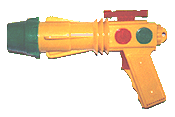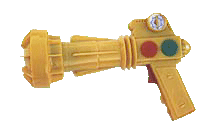
|
The Birth of Buck There were no ray guns before Buck Rogers. There was no reason for any. For although tales of science fiction were not new in the late 1920s when the first Buck comic strip was published, space stories had not yet produced a popular character whose exploits and equipment c Anthony "Buck" Rogers was born in August of 1926 in an early edition of the pulp magazine, Amazing Stories. Introduced in the story "Armageddon 2419" by Philip Nowlan, Rogers was an air force officer who lapsed into a coma and awakened in the 25th century where he found America in ruins and the world dominated by Mongolians from inland China. Quickly discovering the marvels of this future world, including anti-gravity belts, rocket pistols, and space ships, Rogers and his cohorts, the lovely Wilma Deering and the intrepid scientist Dr. Huer, set out to fee the world and battle evil and injustice. At about this same moment, the editors of the National Newspaper Service began looking for a new adventure comic strip, and so Philip Nowlan and illustrator Dick Calkins were commissioned to inauguratea syndicated comic strip based on Nowlan's story. Anthony Rogers' name was changed to "Buck" to recall the popular heloes of America's Wild West, and the new Buck Rogers comic strip made its first appearance in January of 1929. An almost instant success, it ran for over forty years. A radio adaptation was broadcast from 1932 to 1947, movies were made, and television versions appeared in both the 1950s and 1980s. Buck Roger Paper Guns
The first ray gun was made of cardboard and was produced as a mail-away premium by Cocomalt cerial, one of the early sponsors of the Buck Rogers radio drama. Created in 1933, the gun was just one of many advertising premiums offered by numerous companies to "cash in" on Buck's increasing popularity. From storybooks to space costumes and games to model rocketships, Buck Rogers merchandise became one of the most popular premiums in American advertising history. Like many other premiums which encouraged children to act out, and thus more completely identiify with, the adventures of the characters associated with the product being promoted, the Cocomalt Buck Rogers cardboard pop gun was offered as part of a "playset." This playset included not only a gun but also a Buck Rogers or Wilma Deering cardboard helmet. The gun is "fired" with a flick the wrist, causing a sheet of folded paper inside the gun to pop as it snaps out.
Rocketing to Success: The XZ-31 Despite the popularity of the cardboard Buck Rogers ray gun premiums, it was the metal Buck Rogers ray guns made by Daisy Manufacturing Co. that really captured the popular imagination. First introduced by Daisy in 1934, these guns were the beneficiaries of one of the most successful merchandising and sales campaigns in the history of the American toy business. Daisy began this remarkable campaign by convincing Nowlan and Calkins to redesign the hand guns, helmets, and holsters portrayed in Buck's comic adventures so that they could be exactly Despite initial skepticism about the XZ-31 (many toy buyers at the toy fair thought Buck Rogers was a cowboy!) Macy's Department Store in New York City agreed to promote the gun in exchange for a one week exclusive on its sales. Using the rocket ship and extra-terrestrial figures from J.L. Hudson, Macy's promotion was so successful that, on the day the guns went on sale, over 2,000 people stood in line outside their doors to buy the Rocket Pistol. As the week went on the crowds grew, and in order to keep Macy's supplied, Daisy kept trucks on the road every day from their Michigan plant. Following this first week promotion, the XZ-31 was shipped to stores across the country, including Gimbel's, Macy's rival department store in New York City. As soon as Gimbel's received their guns, they cut the price below the forty-nine cents which Macy's had been charging. This started a price war between the two stores. Within a few weeks Gimbel's was pricing their guns at two for nineteen cents - stubstantially below their cost! Prices of the Rocket Pistol changed almost hourly in each of the stores, except when one of them ran out of the toys, at which time the other store raised its price. While this was going on, Daisy exacerbated and profited from this situation by sending people into whichever store had the lowest price and buying back its guns which were then sold to the other store. According to Cass Hough, Daisy sales manages at the time, "during those first two weeks the Gimbel's and Macy's toy departments looked like a cyclone had struck, and people were still lining up to buy." Soon almost every toy store in the country was clamoring for shipments of the XZ-31 and Daisy could not get enough steel material or cardboard boxes to keep up with the production demand. For Christmas that year Daisy developed a Buck Rogers holster and helmet to go with the Rocket Pistol, and the next year they produced a smaller version of the Rocket Pistol, the XZ-35 or "Wilma" pistol. The Last Daisy Following up on the success of the Rocket Pistol and the surging popularity of Buck Rogers, in 1935 Daisy produced a new Buck Rogers gun, the XZ-38 Disintegrator Pistol. A masterpiece of art deco design, this gun featured a fluted barrel and flamboyant fins. Produced in both nickel and copper finishes, the gun was both sold in stores as well as merchandised as a Cream of Wheat premium in 1935 and a Popsicle pr In 1936 Daisy brought out one of the most colorful Buck Rogers toy guns, the XZ-44 Liquid Helium Water Pistol, finished in bright yellow and red lightinig bolts. (It also came in a plainer, but no less striking, copper color.) Made before plastic was used in the manufacture of toys, this metal squirt gun utilized an interior leather sack to hold the water and was advertised as a "25 shot repeater."
After World War II, Daisy used the existing tools and dies from the Disintegrator Pistol to create their last Buck Rogers gun. Called the U-235 Atomic Pistol, this gun reflected the then current fascination with atomic energy. This gun was available with a blued finish, in unfinished steel, or painted gold.
Buck Rogers Ray Guns of the 1950s
Although Daisy never produced another new Buck Rogers ray gun after the mid 1940s, the company continued to use some of the old Buck Rogers tools and dies to manufacture new toys. In about 1952 Daisy recycled the original Buck Rogers Rocket Pistol to produce the Zooka Pop Pistol, a gun which was identical to the 1930s model except for its bright, multicolored lithographed finish. Like the Rocket Pistol, this gun was armed by cocking the handle.
The last two Buck Rogers ray guns produced in the 1950s were flashlight guns made by Norton Honer. First marketed in the mid 1950s, the Sonic Ray became so popular that it not only served as a model for many subsequent flashlight guns made by other companies, but also probably inspired Norton Honer to produce its second flashlite gun.
Made a few years after the Sonic Ray, the Super Sonic Ray is a more successful design. With its fluted, trumpet-like barrel and rakishly exagerated rear site it has a more imposing visual presence.
The Significance of Buck's Early Guns Although there were many other significant toy rayguns produced in the 1930s, 1940s, and 1950s besides those associated with Buck Rogers, the Buck Rogers ray guns (especially those made by Daisy) are among the most important toy ray guns ever produced. Associated with the swashbuckling adventures of the first space hero, and one of the most popular American mythic heroes of all time, these toy ray guns embody the excitement, adventure, and hope and that came to be associated with the discovery of space as a new frontier. Examples of stunning design, the early Buck Rogers ray guns are visual symbols of the exuberance and confidence with which Americans faced a new and uncertain future in the cosmos, and these toys established a model and standard in terms of which all other space guns (and space toys) can be judged and understood.
|

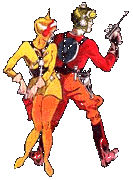 ould be widely or profitably marketed.
ould be widely or profitably marketed.  s became THE American space hero, and one of the greatest pop culture heroes of all time. So insatiable was the public appetite for the daring space traveler that he spawned another popular space hero, Flash Gordon, who was created in 1934 by King Features to compete with the Buck Rogers comic strip. Like Buck, Flash soon became a comic book hero and radio star, and over the years, he appeared in the movies and on television. By the end of the 1930s, Buck Rogers and Flash Gordon had transformed space into a popular and well-known adventure setting. More important, until the inauguration of the space race in the 1950s and early 1960s, Buck Rogers and Flash Gordon were probably responsible for teaching most people what they knew about outer space.
s became THE American space hero, and one of the greatest pop culture heroes of all time. So insatiable was the public appetite for the daring space traveler that he spawned another popular space hero, Flash Gordon, who was created in 1934 by King Features to compete with the Buck Rogers comic strip. Like Buck, Flash soon became a comic book hero and radio star, and over the years, he appeared in the movies and on television. By the end of the 1930s, Buck Rogers and Flash Gordon had transformed space into a popular and well-known adventure setting. More important, until the inauguration of the space race in the 1950s and early 1960s, Buck Rogers and Flash Gordon were probably responsible for teaching most people what they knew about outer space.
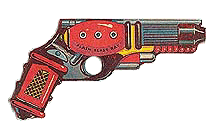 A second Buck Rogers paper gun, called a "Flash Blast Ray," was produced in 1937 by Warren Paper Products Inc. Like the Cocomalt gun, this rubber-band shooting gun came as part of a set which encouraged children to act out Buck's adventures. In this case, the gun accompanied a "Rocket Ship Control Base" with a launching platform which propelled cardboard rockets to Mars, Saturn and Jupiter. Inside the Control Base is Dr. Huer's laboratory.
A second Buck Rogers paper gun, called a "Flash Blast Ray," was produced in 1937 by Warren Paper Products Inc. Like the Cocomalt gun, this rubber-band shooting gun came as part of a set which encouraged children to act out Buck's adventures. In this case, the gun accompanied a "Rocket Ship Control Base" with a launching platform which propelled cardboard rockets to Mars, Saturn and Jupiter. Inside the Control Base is Dr. Huer's laboratory. 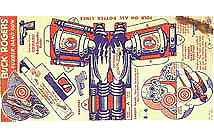 1940 saw the production of the third Buck Rogers paper gun. Offered in the fall as a sales promotion for Onward School Supplies, this toy came on a punch out sheet which included standup targets of a sea monster, a villain called Wing Bat Wu, and a spacehip.
1940 saw the production of the third Buck Rogers paper gun. Offered in the fall as a sales promotion for Onward School Supplies, this toy came on a punch out sheet which included standup targets of a sea monster, a villain called Wing Bat Wu, and a spacehip. 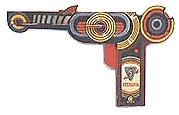 The final Buck Rogers paper gun was offered by Sylvania Electric Products in 1952 as part of a Buck Rogers Space Ranger Kit that was given away with Sylvania products. The kit included six full color punch-out sheets which could be made into a gun as well as a paper helmet, badge, targets, a rocketship launch pad and other toys.
The final Buck Rogers paper gun was offered by Sylvania Electric Products in 1952 as part of a Buck Rogers Space Ranger Kit that was given away with Sylvania products. The kit included six full color punch-out sheets which could be made into a gun as well as a paper helmet, badge, targets, a rocketship launch pad and other toys. 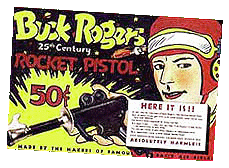 duplicated by Daisy. Then in February of 1934, after the Buck Rogers comic strip and radio show had developed a significant following and a strong market potential for Buck Rogers' toys, Daisy introduced their first Buck Rogers gun, the XZ-31 Rocket Pistol. Before the introduction of the XZ-31, Daisy had already convinced the J.L. Hudson department store in Detroit to make "Buck Rogers in the 25th Century" their Christmas theme, and to install a large rocket ship and set of Martian figures in their toy department. Daisy then used these same props when it finally introduced its Buck Rogers gun at the prestigious American Toy Fair.
duplicated by Daisy. Then in February of 1934, after the Buck Rogers comic strip and radio show had developed a significant following and a strong market potential for Buck Rogers' toys, Daisy introduced their first Buck Rogers gun, the XZ-31 Rocket Pistol. Before the introduction of the XZ-31, Daisy had already convinced the J.L. Hudson department store in Detroit to make "Buck Rogers in the 25th Century" their Christmas theme, and to install a large rocket ship and set of Martian figures in their toy department. Daisy then used these same props when it finally introduced its Buck Rogers gun at the prestigious American Toy Fair.
 Buck Rogers Guns: The XZ-38, XZ-44, and U-235
Buck Rogers Guns: The XZ-38, XZ-44, and U-235  emium in 1939..
emium in 1939.. 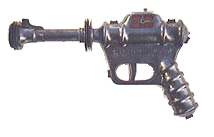
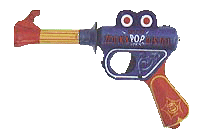
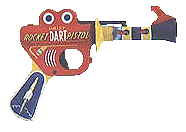 A short while after Daisy produced the Zooka Pop Pistol, the company again reused the Rocket Pistol tools and dies to make the Rocket Dart Pistol, a toy gun which shot darts instead of simply making a popping noise. Unlike the Zooka Pop Pistol, the Rocket Dart Pistol was slightly reengineered from the original mould in order to make it a dart shooter. To fire this gun one pulls the trigger which raises a bar on the top of the barrel to release the dart in the barrel.
A short while after Daisy produced the Zooka Pop Pistol, the company again reused the Rocket Pistol tools and dies to make the Rocket Dart Pistol, a toy gun which shot darts instead of simply making a popping noise. Unlike the Zooka Pop Pistol, the Rocket Dart Pistol was slightly reengineered from the original mould in order to make it a dart shooter. To fire this gun one pulls the trigger which raises a bar on the top of the barrel to release the dart in the barrel.